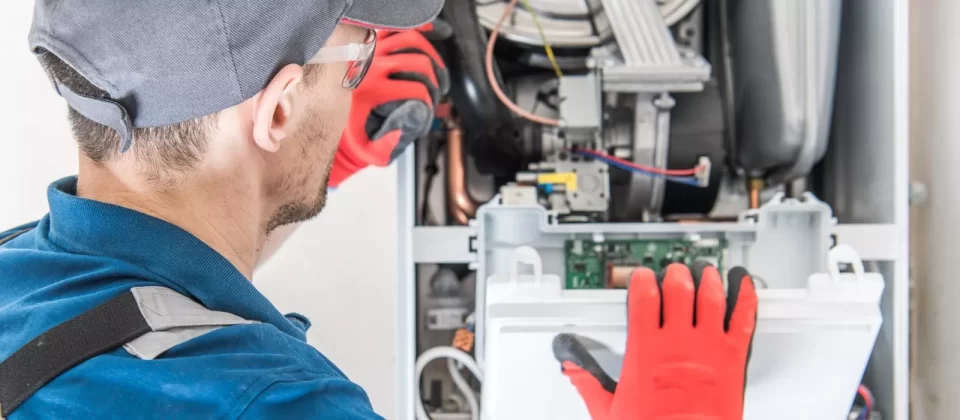When your AC dies on a scorching summer day, it’s not just inconvenient—it’s chaos. That’s why predictive maintenance is a game changer for HVAC systems. Instead of waiting for something to break, it spots the warning signs early and keeps everything running smoothly. It’s like having a smart safety net that saves you from surprise breakdowns, costly repairs, and sleepless nights in a sweltering house.
With the right tools and data, your HVAC can tell you when it needs attention long before trouble hits—keeping your comfort (and your wallet) safe year-round.
How Does Predictive Maintenance Differ From Preventive Maintenance For HVAC?
Preventive maintenance is the checklist: seasonal tune-ups, filter changes, belt inspections, coil cleaning. It’s invaluable, and it keeps systems running more efficiently than a “run-to-failure” approach ever could. But preventive maintenance is based on time like every quarter, every season, every year.
Predictive maintenance, on the other hand, is based on condition. It uses sensor data and operating trends to answer a different question: What is about to go wrong, and when? Think of it like health care:
- Preventive: Your regular physical—helpful, scheduled, and necessary.
- Predictive: Your wearable heart monitor that flags anomalies in real time, so a doctor can act before a crisis.
Where preventive maintenance might say, “replace this belt every six months,” predictive maintenance says, “this belt’s tension is drifting, vibration is increasing, and the motor is drawing more current than last month—plan a replacement in the next two weeks.” One tells you when it’s been six months; the other tells you when the belt itself is telling you it’s time.
What Technology is Used to Predict HVAC System Failures?
Predictive maintenance isn’t magic; it’s measurement plus math. The tools are straightforward, scalable, and more affordable than most people expect.
Common building blocks include:
- IoT Sensors: Wireless sensors measuring temperature, humidity, pressure, vibration, motor current (amperage), and differential pressure across filters and coils. These are the eyes and ears of your HVAC system.
- Smart Gateways & BAS/BMS Integration: Gateways collect sensor data and pass it to the cloud or your building automation system, where it’s normalized and compared against baselines.
- Runtime & Cycle Counters: Not glamorous—but tracking how long a component runs and how often it cycles is essential for predicting wear.
- Vibration & Acoustic Monitoring: Subtle changes in vibration patterns can signal bearing wear, fan imbalance, or motor misalignment well before you’d hear or feel it in the space.
- Electrical Signature Analysis: Spikes in current draw, power factor changes, and start/stop signatures can reveal compressor stress, short cycling, or failing contactors.
- Thermal Imaging & Smart Cameras: A quick thermal scan can reveal uneven coil loading, hot electrical connections, or insulation breakdowns.
- Cloud Analytics & Mobile Dashboards: The brains of the operation. Data is aggregated, trended, and scored so you have a clear “green/yellow/red” view of risk and urgency across sites.
A modern predictive setup doesn’t require a full rip-and-replace of your existing BAS. In many cases, it’s as simple as adding edge sensors to critical assets like rooftop units, chillers, pumps and feeding their data into a platform that can do the boring but important work of pattern recognition.
How Does Data Analysis Help in Forecasting HVAC Equipment Issues?
Here’s where the fun begins. Raw readings alone won’t save you from an emergency. Insight will. Predictive maintenance uses data analysis to transform thousands of datapoints into practical, prioritized actions.
What the analysis actually looks at:
- Trend Drift: Are discharge pressures creeping up week over week? Is the compressor taking longer to reach setpoint? Drift tells a story—often one of coil fouling, low refrigerant, or a failing expansion valve.
- Anomaly Detection: When a unit behaves differently from its historical pattern under similar conditions, it’s a red flag. For instance, identical rooftop units on the same building shouldn’t diverge dramatically in energy use unless one is slipping.
- Correlation & Root Cause: Rising fan vibration plus increasing motor current often points to bearing wear. Elevated supply air temperature with normal compressor amps might indicate airflow restrictions rather than a refrigerant issue.
- Load vs. Performance Modeling: Data analysis compares outside air temp, occupancy proxies (like CO₂), and run time to expected performance. If your system is working harder for the same outcome, it’s inefficient—or on the road to failure.
- Remaining Useful Life (RUL) Estimates: By comparing live data to known failure profiles, analytics can estimate how many cycles or hours a component has left before the risk becomes unacceptable.
The payoff is operational clarity:
- Instead of discovering an issue when tenants complain, you get a dashboard alert on Tuesday that says:
“RTU-3 filter ΔP rising 20% faster than normal; schedule replacement this week to prevent coil icing.” - Instead of rolling a truck blindly, your tech arrives with the exact part, because the analytics already narrowed it down to a failing condenser fan motor on Unit 5.
Even better, the data enables smarter budgeting. When you know which components are trending toward failure in Q4, you can plan ahead—no surprise line items, no emergency markups, no late-night overtime.
What are the Primary Benefits of Predictive Maintenance For Commercial HVAC Systems?
Let’s talk results. For property managers, facility directors, and operations leaders, predictive maintenance translates into tangible wins.
1) Fewer Emergencies (and Fewer Headaches)
Catching problems early slashes unplanned downtime. That means fewer 2 a.m. calls, fewer angry tenants, and far less disruption to business-critical spaces like server rooms and labs.
2) Lower Total Cost of Ownership
Repairs done proactively are almost always cheaper than emergency fixes. You avoid expedited parts, weekend labor rates, and collateral damage (like a failed fan motor that takes a compressor down with it). Plus, optimized operation reduces energy waste—often a hidden budget drain.
3) Longer Equipment Lifespan
Short cycling, high superheat, imbalanced fans—these stressors quietly shorten lifespan. Predictive maintenance identifies them before they become chronic, extending the useful life of your assets.
4) Better Comfort and IAQ
Comfort complaints usually start with inconsistent control. Predictive insights keep airflow, temperature, and humidity in the Goldilocks zone. Sensors monitoring filter loading, coil performance, and ventilation rates help keep indoor air quality steady and healthy.
5) Cleaner Workflows and Happier Technicians
When technicians know exactly what they’re walking into, the job goes faster and safer. Clear, data-backed work orders reduce diagnostic time and the “try this, try that” cycle.
6) Audit-Ready Documentation
For compliance-heavy environments like healthcare, manufacturing, education, automated logs and trend reports make audits painless. You can demonstrate that systems are maintained based on measurable risk, not just a calendar.
Quick-hit benefits you’ll feel right away:
- Fewer hot/cold calls from occupants
- Reduced overtime and after-hours disruptions
- More predictable maintenance windows
- Lower utility bills from optimized operation
- A clearer capital plan rooted in data, not guesswork
Where to start (and what to avoid):
- Start with your critical assets. Prioritize units that support mission-critical spaces or have a history of issues.
- Instrument for the right signals. You don’t need every sensor everywhere. Pick the ones that map to common failures (vibration, amps, ΔP, coil temps).
- Insist on actionable dashboards. Pretty graphs are nice; prioritized alerts with clear next steps are better.
- Integrate with existing PM. Predictive doesn’t replace preventive—it makes it smarter. Use insights to refine your seasonal checklist.
- Avoid alert fatigue. Tune thresholds and rely on trend analysis to reduce noise. The best systems highlight meaningful deviations, not every wobble.
Stay Ahead of HVAC Breakdowns—Book Your Predictive Tune-Up with Elite Air & Heat!
Stop waiting for your HVAC system to fail before taking action. With a predictive tune-up from Elite Air & Heat of Columbia, you’ll catch small issues before they turn into costly repairs. We’ll install the right sensors, create a clear dashboard, and focus on the equipment that truly affects your building’s comfort and performance.
See what your system’s data is already saying and use it to plan better, spend wiser, and keep your space running smoothly. Schedule your tune-up today and breathe easier year-round.



